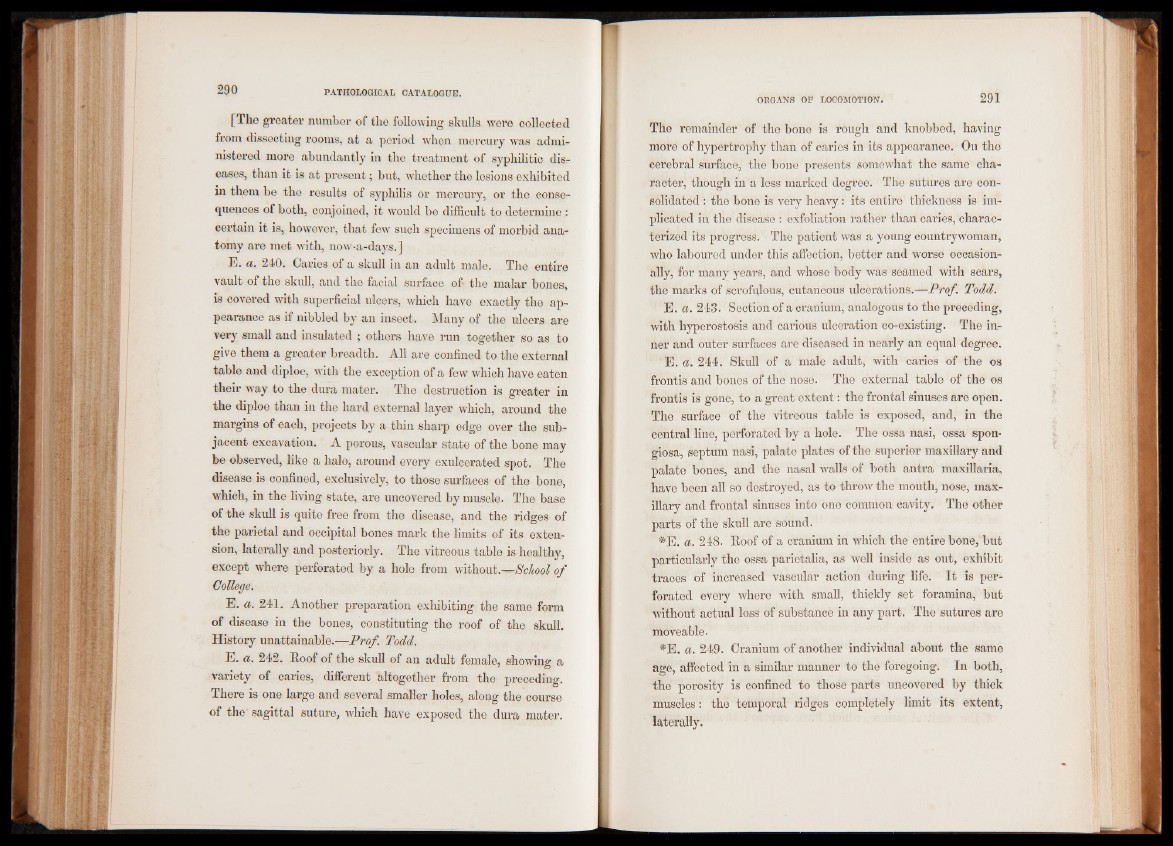
[The greater number of the following skulls were collected
from dissecting rooms, at a period when mercury was administered
more abundantly in the treatment of syphilitic diseases,
than it is at present; but, whether the lesions exhibited
in them be the results of syphilis or mercury, or the consequences
of both, conjoined, it would be difficult to determine :
certain it is, however, that few such specimens of morbid anatomy
are met with, now-a-days.]
E. a. 240. Caries of a skull in an adult male. The entire
vault of the skull, and the facial surface of- the malar bones,
is covered with superficial ulcers, which have exactly the appearance
as if nibbled by an insect. Many of the ulcers are
very small and insulated ; others have run together so as to
give them a greater breadth. All are confined to the external
table and diploe, with the exception of a few which have eaten
their way to the dura mater. The destruction is greater in
the diploe than in the hard external layer which, around the
margins of each, projects by a thin sharp edge over the subjacent
excavation. A porous, vascular state of the bone may
be observed, like a halo, around every exulcerated spot. The
disease is confined, exclusively, to those surfaces of the bone,
which, in the living state, are uncovered by muscle. The base
of the skull is quite free from the disease, and the ridges of
the parietal and occipital bones mark the limits of its extension,
laterally and posteriorly. The vitreous table is healthy,
except where perforated by a hole from without.—School of
College.
E. a. 241. Another preparation exhibiting the same form
of disease in the bones, constituting the roof of the skull.
History unattainable.—Prof. Todd.
E. a. 242. Roof of the skull of an adult female, showing a
variety of caries, different altogether from the preceding.
There is one large and several smaller holes, along the course
of the' sagittal suture, which have exposed the dura mater.
The remainder of the bone is rough and knobbed, having
more of hypertrophy than of caries in its appearance. On the
cerebral surface, the bone presents somewhat the same character,
though in a less marked degree. The sutures are consolidated
: the bone is very heavy: its entire thickness is implicated
in the disease : exfoliation rather than caries, characterized
its progress. The patient was a young countrywoman,
who laboured under this affection, better and worse occasionally,
for many years, and whose body was seamed with scars,
the marks of scrofulous, cutaneous ulcerations.—Prof. Todd.
E. a. 243. Section of a cranium, analogous to the preceding,
with hyperostosis and carious ulceration co-existing. The inner
and outer surfaces are diseased in nearly an equal degree.
E. a. 244. Skull of a male adult, with caries of the os
frontis and bones of the nose. The external table of the os
frontis is gone, to a great extent: the frontal sinuses are open.
The surface of the vitreous table is exposed, and, in the
central line, perforated by a hole. The ossa nasi, ossa spon-
giosa, septum nasi, palate plates of the superior maxillary and
palate bones, and the nasal walls of both antra maxillaria,
have been all so destroyed, as to throw the mouth, nose, maxillary
and frontal sinuses into one common cavity. The other
parts of the skull are sound.
#E. a. 248. Roof of a cranium in which the entire bone, but
particularly the ossa parietalia, as well inside as out, exhibit
traces of increased vascular action during life. It is perforated
every where with small, thickly set foramina, but
without actual loss of substance in any part. The sutures are
moveable.
*E. a. 249. Cranium of another individual about the same
age, affected in a similar manner to the foregoing. In both,
the porosity is confined to those parts uncovered by thick
muscles: the temporal ridges completely limit its extent,
laterally.